به نام خداوند جان و خرد
اینک که چندسالی تا پایان قرن چهاردهم خورشیدی باقی مانده است و در آستانهء ورود به قرنی جدید قرار داریم، وقت آن رسیده تا به خود بنگریم و تصمیم بگیریم که آیندهء ایران و ایرانی را چگونه میخواهیم.
بیش از یکصد سال از تحولات اجتماعی، دینی و فرهنگی در ایران میگذرد. در این میان دین و مذهب رکنی از ارکان تغییر در اوضاع کشور ما بوده است. اما، نگاه عموم مردم و نیز سیاستپیشگان یا عمدهء متفکرین ایرانی بیش از همه به دستهبندیهای غالب و مغلوب بین آحاد شهروندان ایرانی نظر داشته و در رأس نگاه خویش، مذهب و دین متعلق به خود را جای دادهاند. این در حالی است که سرزمینی که به ما به میراث رسیده در مرزهای ایران امروز خلاصه نمیشود و تمامی منطقهء ما از ریشههای مشترک فرهنگی و دینی متفاوتی برخوردار است؛ همچنین تحولات جاری در نظام سیاسی، اجتماعی و دینی ایران بر تمامی ایرانیان اعم از مسلمانان شیعهء سنتگرا، شیعیان دگراندیش، اهل تسنن و فرق تابعه، زرتشتیان، بهاییان، یارسانان، مندائیان، کلیمیان و مسیحیان تاثیر گذاشته است. این کمترین بر این باور هستم که هرگز نمیتوان از بحرانهای پشتدرپشت ایران عبور کرد، مگر آنکه بنیاد نگاه و تفکر خود را از تعصبات و خویشتنپرستیهای قومی و عقیدتی رها کنیم و در موضع دینی خود دست به بازنگری و دگرگونی بزنیم.
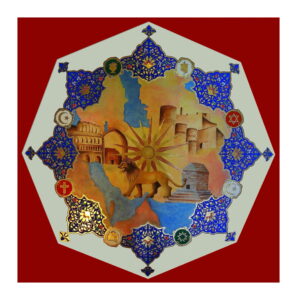
این اثر هنری نمادین که به تمامی هموطنان ایرانی تقدیم شده، حامل میراثی از فرهنگ ادیان و مذاهب مندایی، مسیحی، کلیمی، زرتشتی، بهایی، یارسانی، شیعه و تسنن است. پیام این اثر فقط اشاره بر یک دعوت ساده برای همگرایی ادیان و مذاهب ایرانی ندارد، بلکه مدعی است که تنها زمانی میتوانیم ایرانی یکپارچه و همبسته داشته باشیم که تفاوتهای دینی و مذهبی خود را بهرسمیت شناخته و هیچ دین و مذهبی را با هیچ بهانهای برتر از دیگران ندانیم؛ و در کنار آن بر شباهت بنیادین خود بهعنوان انسانهایی تاکید کنیم که از کرامت و منزلت ذاتی برخوردار است و حقوق اساسی و شهروندی ما بهخصوص در آزادی انتخاب سبک زندگیمان با هم برابر و یکسان میباشد. ثمرات تأکید همهء ما بر چنین باوری نهتنها به انسجام یک فرهنگ واحد ملی، اما برخوردار از ماهیتی چنددینی و چندمذهبی در ایران کمک میکند؛ بلکه از گسترش و ترویج دروغ و ریاکاری و فساد و انحصارطلبی دینی و قومی جلوگیری کرده، زمینهء برقراری صلح و مودت را در مناسبات انسانی در تمامی منطقهء خاورمیانه ایجاد خواهد کرد.
هشت دین و مذهبی که در این اثر بر گرد دایرهء وجود یکپارچهء تاریخ انسانی این کشور در کنار یکدیگر قرار گرفتهاند، هر یک پشتیبان ذخایر معنوی-دینی فرهنگ ملی ایران و سراسر منطقهء ما هستند. زرتشتیان؛ کلیمیان؛ مسیحیان؛ مندائیان؛ یارسانیان؛ بهاییان؛ مسلمانان اهل تسنن و تشیع؛ هر کدام بخشی از فرهنگ و میراث کهن ایران را تشکیل داده و بههمراه دارند. در حقیقت تمامی ما ایرانیان حامل میراثی بینظیر از تاریخ و فرهنگ و دین هستیم که نظام ملی این سرزمین بدون یکی از آنها نمیتواند کامل باشد، و بدون پاسداشت همهء آنها نمیتوانیم در کشور و کل منطقه امنیت و شکوفایی را به ارمغان آوریم.
با وجود آنکه هیچ هنرمندی حاضر نیست تا اثر هنری خود را قطعهقطعه و ناقص کند، اما با قطعهقطعه شدن این اثر مایل هستم همهء هموطنان گرانقدر خود را متوجه این مهم کرده باشم که پافشاری متعصبانه بر عقاید دینی خود و غفلت از اشتراکات انسانی ما با دیگر ادیان و مذاهب، نتیجهای جز جدایی روحی، عاطفی، فکری و انسانی ما نخواهد داشت؛ و چنین رویهای به پارهپاره شدن روح ایرانی خواهد انجامید. این در صورتی است که آن ایرانی که هرگز نیاز به اتحاد اقوام و ادیان نداشت و همگی ذیل فرهنگ ایرانشهری یکپارچگی و یگانگی را باور داشتند؛ امروز تجربهء دردناکی از جداییها، دوریگزینیها، مهاجرتها، خصومتها، خشونتها و بیاعتمادیها را به خود میبیند، که اینبار نه به دلیل لشکرکشیها، بلکه به علت غفلتهای ما از حقوق اساسی یکدیگر بروز یافته است. همچنین متفکران ما باید آگاه باشند که اگر مبانی اندیشهء آنان خالی از اصول بنیادین انسانی باشد و بهصرف گرم بودن تنور بحثهای عقیدتی در یک قرائت از مذهب شیعه به غفلت از حقوق ادیان و مذاهب دیگر ادامه دهند، ایشان نیز در این ابتلائات سهیم خواهند بود. این سهم تا آنجا ادامه مییابد که هرگونه نظام فکری ایشان که نتواند ماهیت چنددینی ایران را بهشکلی یکپارچه به تصویر بکشد و روشنفکریهای ایشان نتواند نور و روشنایی بر زندگی اقلیتهای مختلف بتاباند، چنین محصولی خود زمینهء تبعیض و آپارتاید دینی و عقیدتی را پرورش خواهد داد؛ بهخصوص اگر در چهارچوب داوریهای اکثریت و اقلیت فروغلتند و نتوانند از تفاوتهای ظاهری بگذرند و شباهتهای اصیل انسانی را در بطن آراء فکری خود پرورش دهند. همین امر در حوزهء امور ملی نیز صدق میکند، چراکه فرهنگ ملی ما زمانی میتواند قدرت آن را داشته باشد که از همبستگی ملی حمایت کند، که هرگاه سخن از ایران و ایرانی میآید و نامی از مردم برده میشود، فحوای آن بر دل و جان همه از جمله اقلیتها نیز بنشیند.
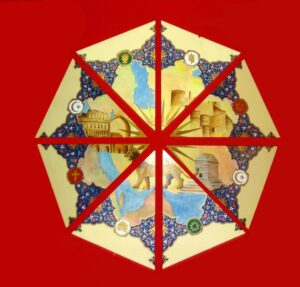
در این اثر هشتاد قطعه الماس بهکار رفته که نشانی از هشتاد میلیون نفوس ایرانی کنونی است، و سهم هر بخش آن ۱۰ عدد الماس شده است که نشان میدهد اکثریت یا اقلیت بودن در تعداد پیروان یک دین و مذهب نهتنها نمیتواند دلیلی بر برتری یکی بر دیگری باشد، بلکه حراست از حقوق اساسی و رسیدگی به نیازهای اختصاصی گروههای اقلیت وظیفهء خطیر انسانی و ملی همهء ما ایرانیان است. در این امر همهء ما شیعیان، سنیان، منداییان، بهاییان، زرتشتیان، کلیمیان، مسیحیان و یارسانیان باید مسئولیت انسانی خود را برعهده بگیریم. همچنین باید توجه داشته باشیم که تمامی میراثهای ملی ما، که چندی از آنها در این اثر به تصویر کشیده شده است، همگی به یک فرهنگ یکپارچهء ملی وابسته هستند که هریک از ادیان و مذاهب ایرانی سهمی در آنها دارند. اگرچه بخشی از این میراث امروز در درون مرزهای سیاسی ایران نیستند، اما همین نشان میدهد که میراث متعلق به انسانیت ما الزاماً قرار نیست در مرزهای عقیدتی-خانوادگی ما باشند، بلکه میتوانیم آن را در عقاید دیگر ادیان و مذاهب نیز بیابیم. بدینمنظور لازم است مبانی انسانی را در بطن فرهنگ ملی خود برجستهتر سازیم و بهجای آنکه حیات اجتماعی خود را آلوده به بحثهای پرمناقشه و کشدار به قصد تخریب دیگری و اثبات حقانیت خود کنیم؛ با ترویج و گسترش حس اعتماد و جلب اطمینان یکدیگر بتوانیم به شناختی همدلانه از یکدیگر دست یابیم؛ کما اینکه مسائل زیستمحیطی و احیانا بلایای طبیعی به مرزبندیهای سیاسی و عقیدتی اهمیتی نمیدهند و همهء ما را در معرض زیان خود قرار خواهند داد. در جهان امروز نیاز داریم برای حل کلیهء مسائل و مشکلات اجتماعی، سیاسی یا زیستمحیطی، بنابر اصل یکپارچگی حقوق انسانی عمل کنیم و اگر در اکثریت هستیم، از خودبرتربینی دست برداریم، و اگر در اقلیت هستیم، انزواطلبی نکرده و خواهان مشارکت در امور عامه باشیم؛ چرا که این کشور متعلق به همهء ماست.
ما می بایست به این باور برسیم که به رسمیت شناختن یا نشناختن یک دین یا مذهب هرگز نمیتواند دلیلی بر مشروع بودن مرزبندیها میان حقوق بنیادین شهروندان یک کشور باشد؛ و حق دینداری یک فرد حقی جهانی و برابر برای همگان است. تنها درصورتی که عقیدهء فرد -خواه ناشی از دین و مذهب او باشد یا غیر از آن- موجب تضییع حقوق انسانی فردی دیگر بشود، همگان وظیفه دارند در برابر آن عقیده بایستند. هرگونه مرزبندی میان انسانها میبایست در جهت احقاق حقوق ناشی از تفاوتهای مشروع انسانی باشد، و الا مرزبندیهای غالب و مغلوب دینی یا غیردینی تنها به انسانیتزدایی اجتماعی میانجامد و موجب میشود همدردی، همدلی و همبستگی انسانی جامعه با ابتلائات و دردهای دیگر همنوعان ناممکن شود، و بدنهء جامعه را بیش از پیش به انزواطلبی، عافیتجویی، ظاهرفریبی و فساد سوق دهد. از این بالاتر آنکه: به رسمیت شناختن مرزهای ملی میان کشورهای منطقهء ما هرگز توجیهی بر این نیست که مراتب احترام به کرامت ذاتی نوع بشر را در مناسبات و ارتباطات خود با اتباع کشورهای دیگر زیر پا بگذاریم؛ و چنین مرزبندیهای سیاسی هرگز نباید مانع از آن بشود که در تفکر و عمل خویش بر جهانی کردن ایدهء نیک همبستگی انسانی پای بفشاریم. اصرار بر میهنپرستی و انسجام ملی اگر مبتنی بر عقلانیت و حفظ شئونات انسانی باشد قطعا پذیرفته است؛ اما عزت نفس ملی ما زمانی معنا پیدا میکند که اول: بر گوناگونیهای پیکرهء انسانی کشورمان آگاه باشیم و آن را بپذیریم؛ و دوم، آن را به بستری برای ستیز با این قوم و آن کشور تبدیل نکنیم. به دیگر سخن؛ حفظ حرمت ملی ما، هم به احترام به تفاوتهای درون کشور وابسته است و هم مستلزم تلاش برای حسن همجواری و نیکخواهی در برابر ملتهای همسایه و منطقه خواهد بود.
هر بخش از این اثر به نمایندگان دیانتی که نمادش در آن نقش شده تحویل گردیده است:
• حاخام اعظم کلیمیان ایران بههمراه جمعی از نمازگزاران کلیمی، به نمایندگی از هموطنان یهودی

• جمعی از علماء اهل تسنن کردستان ایران، به نمایندگی از هموطنان سنی
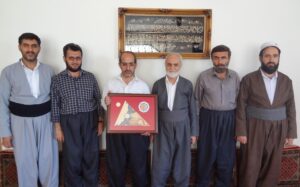
• انجمن صابئین مندائی، به نمایندگی از هموطنان مندائی
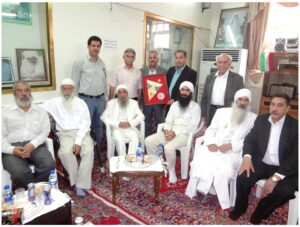
• موبد موبدان و موبد زرتشتیان، به نمایندگی از هموطنان زرتشتی

• جمعی از بهائیان، به نمایندگی از هموطنان بهایی

• نمایندهء یارسانیان از سادات دودمان حیدری، به نمایندگی از هموطنان یارسانی

بخش متعلق به بهائیان به دلیل نداشتن مرکزی در کشور به مرکز جهانی بهائیان امانت داده شده و بخشی که متعلق به مذهب شیعه میباشد، به دلیل عدم وجود تمرکز نهاد و یا استقلال از حکومت، در نزد این کمترین موقتاً باقی مانده است. در کمال تاسف، خلیفهگری ارامنه بنابر ملاحظاتی از دریافت بخش متعلق به دیانت مسیحیت امتناع کرد و این بخش از اثر تا زمان استقلال نهادهای دینی مسیحیت در ایران در نزد اینجانب به امانت باقی خواهد ماند.
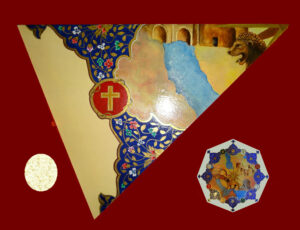
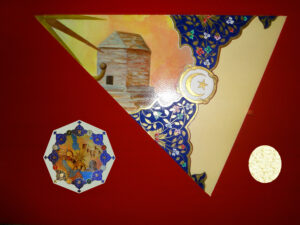
همانطور که پیکرهء انسانی جامعه با گسستگیها و جداییها دچار نقصان و خسران خواهد شد، آن قطعات نیز هر کدام به تنهایی ناقص خواهد بود و زمانی این اثر کامل میشود که تمامی این قطعات در کنار یکدیگر قرار بگیرند. امید دارم که بهزودی و در فضا و نظامی که حرمت انسان به انسان بودنش ارج گذاشته شود، نه به دین و مذهبش؛ و این آب و خاک بدون هیچ تبعیضی به همهء ایرانیان با هر دین و مذهب و گرایش و جنسیتی متعلق باشد، نه فقط متعلق به یک قشر، طبقه، مذهب و اندیشهء دینی؛ این قطعات به عنوان نمادی از همبستگی ملی، تساوی حقوق شهروندی، احترام به حیات انسان و همزیستی همهء اقشار و افکار؛ در محلی در کنار یکدیگر قرار گیرند و دوباره یکپارچه شوند تا تاریخ باشکوه این سرزمین را بار دیگر به نمایش بگذارند.
امید و آروزی این کمترین آن است که حتی اگر عمری برای بنده باقی نمانده باشد تا سروسامان گرفتن امر کرامت انسانی و احقاق حقوق اساسی تمامی ایرانیان را شاهد باشم، اما سعی و تلاش خود را در حد وسع و توانم به خرج داده و زمینهای فکری و عملی را برای نزدیک شدن قلبهای ایرانیان با هر عقیده، دین، مذهب و باوری که دارند ایجاد کرده باشم. این کمترین باور دارم، تحرکات امروزی در ایران و جهان در جهت توجه و تعمق در موضوعات انسانی، بهخصوص در مورد اقلیتهای دینی و مذهبی سرزمین ایران، موجب خواهد شد تا فرهنگ ملی ما با همبستگی انسانیمان جانی تازه بگیرد، و در آیندهای نهچندان دور، ثمرات ارزشمند و پایدار خود را در اختیار نسلهای آتی در تمامی منطقه بگذارد.
تهران – ایران
الراجی؛ عبدالحمید معصومی تهرانی
In the name of the Lord of both life and mind
Now that the fourteenth century in the solar calendar is coming to an end, and we are entering a new century, the time has come for us to reflect upon ourselves and decide on how we want to be the future of Iran and Iranians.
More than a century has passed since the inauguration of social, religious, and cultural transformations of Iran. Amidst all these changes, religion has been one of the primary agents of change in our country. However, the general public, as well as politicians or even some Iranian intellectuals, view religion in the context of the majority and minority groupings and hold the belief that their religion is superior to other faiths. In this regard, it is worthwhile to mention that historically the whole region we have called our homeland shares common cultural and religious roots. Also, the current changes happening in Iran’s political, social and religious system have affected all Iranians including the traditionalist and progressive Shia communities, Sunni Muslims, Zoroastrians, Baha’is, The Yarsan or Ahl-e Haqq, Mandaeans, the Jewish community, and Christians. This lowly one believes that the only way to overcome and put an end to the series of crisis that has been happening in Iran is to liberate our thoughts and minds from all types of racial and religious prejudices and egocentrism and to reflect upon and transform our religious stance, accordingly.
This symbolic piece of art is presented to all fellow Iranians who are the carriers of Christian, Jewish, Zoroastrian, Baha’i, Yarsan, Mandaean, Shia and Sunni cultural and religious heritage. The message presented by this piece of art is not merely a simple invitation to cooperation, but rather to emphasize that the only way to have and maintain a united Iran is to acknowledge our religious differences and abolish any sense of religious superiority. We have to stress our fundamental similarities, innate sense of human dignity, equal human and citizenship rights, and, in particular, the freedom to choose one’s way of living. The outcome of these ideas and beliefs contributes to strengthening our national culture while consolidating the foundation of a multi-faith identity in Iran. It also prevents the spread of dishonesty, hypocrisy, corruption, religious and ethnic monopoly and creates the grounds for peace and reconciliation in the entire Middle East.
The eight religions that are presented in this piece are parts of a circle of unity that have historically considered as essential aspects of Iran’s national culture as well as the entire region’s spiritual and religious reservoir. Zoroastrians, Jews, Christians, Mandaeans, Yarsanian, Baha’is, and Sunni and Shia Muslims, all carry an essential part of Iran’s ancient culture and heritage. In fact, the national system of this country is composed of all religions of Iran, each bearing a unique heritage of its history, culture, and religion. Our national identity would be incomplete without each one of them. Furthermore, it would be impossible to implement security and progress in the nation and the whole region without appreciating each and every one of these religions.
Even though artists are unlikely to cut their own work into pieces intentionally, I have acquiesced to split this work of mine into distinctive fragments to symbolically express the importance of one sensible and crucial matter to my fellow compatriots. The issue at hand is that dogmatic insistence on one’s own religious beliefs and carelessness towards universal human characteristics that are shared by the followers of all religious beliefs would result in emotional, spiritual, and mental separation and lead to the breakdown of the Iranian spirit, similar to this fragmented artwork. Iran once had a reputation for uniting diverse religions or ethnicities. Today, however, we are suffering from agonizing experiences of isolation, separation, displacement and exile, conflict, hostility, and distrust within the nation. These complications did not arise as a result of the armed intrusion but rather resulted from our own negligence towards each other’s fundamental human rights. Our intellectuals and thinkers should also be aware that if their discourse is bereft of basic human rights and focused on particular Shia narratives that ignore other religions’ rights, they too will be an accomplice in arising afflictions. Their intellectual framework should shed light on lives of various religious minorities and portray a unified vision of a multi-faith Iran. If those who aspire to be thought leaders are not capable of illuminating the life of diverse minorities, they would ultimately contribute to the cultivation of discrimination and religious apartheid. This matter also holds true in the area of national affairs. Our national culture only has the power to support national sovereignty if each and every time the words Iran and Iranian are uttered, the real meaning and implications of those words would illuminate the hearts and minds of everyone including minority groups.
Eighty pieces of diamonds are used in this work symbolizing Iran’s current population of eighty million individuals. Each piece is set with ten diamonds to demonstrate that being part of the majority or minority religion does not imply superiority towards others; it rather indicates that preserving the rights of minority groups and exclusively attending to their matters is the human and patriotic duty of all Iranians. It is the responsibility that is laid upon the shoulders of Shias, Sunnis, Mandaeans, Baha’is, Zoroastrians, Jews, Christians, and Yarsanians. We also have to be mindful that our entire national heritage, many of them illustrated in this work, are actively connected to an integrated national culture that all religious groups in Iran are part of it. Today, the entirety of this heritage is not defined by the political boundaries of Iran. However, the human side of our heritage is not bound to our familial beliefs; it is universally shared by the belief systems of all religious traditions. Therefore, it is essential to highlight the humanitarian aspects of our national culture. Instead of poisoning our social life with lengthy disputes intended to destroy others and justify ourselves, we need to promote a sense of mutual trust and sympathetic understanding towards each other. For the same reason that environmental issues and natural disasters are not limited to political and religious boundaries and affect everyone regardless of ethnicity and faith, in today’s interconnected world, we need to act and rely on universal human rights to resolve our social, political and environmental issues. If we belong to the majority group, we must let go of any trace of superiority, and, if we are a minority, instead of choosing isolationism, we have to actively participate in public affairs because this country belongs to us all.
We must understand that government-sanctioned endorsement or censure of religion does not constitute a basis for discrimination or denial of fundamental human rights; the right to have freedom of religion is universal and should be respected around the world. If any belief system – religious or secular – disregards the human rights of other people, everyone is accountable and duty bound to confront that belief. Any demarcation between human beings based on religion or belief system results in social alienation; the society becomes so bereft of compassion, and the body politic of the nation is impelled toward isolationism, opportunism, and corruption. More importantly, national borders among the countries of the region should not be used to legitimize nationalistic tendencies and discriminatory behaviors in our relations with the citizens of other nations. These political demarcations must never restrain us from basing our thoughts and actions on the essential oneness of all human beings. The emphasis on patriotism and national integration is certainly acceptable when it is based on reason and the preservation of human dignity. Our national honor would make meaningful sense only if we are mindful of the nation’s diverse structure, internally, and the need collaboration and goodwill with our neighboring countries and the world as a whole, externally.
This artwork consists of eight pieces, symbolically representing eight historical religions of Iran. Each piece has been delivered to the followers of the religion represented by the symbol.
The Chief Rabbi of Iranian Jewry along with a Jewish worship group, representing our Jewish fellow countrymen
A group of Sunni scholars from Kurdistan, Iran; representing our Sunni fellow countrymen
The Association of Sabean-Mandaean religious community, representing our Mandaeans fellow countrymen
The Mobedan-e-Mobed and a Zoroastrian Mobed, representing our Zoroastrian countrymen
A group of Baha’is, representing the Baha’i community of Iran
The Representative of Yarsanis from the Sadaat of the Heidari Dynasty, representing our Yarsanis fellow countrymen
The section belonging to the Baha’is has been presented to the Baha’i World Center since there is no Baha’i Center in the country. The section pertaining to Shia Muslims is temporarily kept in possession of this lowly one since there is neither sole authority nor institutions independent from the government. Unfortunately, the Armenian Caliphate Council (the Armenian Khalifa- Gari) for some considerations refused to accept the section representing Christians in Iran.
As the body politic of human society would suffer because of estrangements and separations, likewise each section of this piece would be incomplete if it remains unaccompanied by the other sections. This piece is only complete when all the parts are put together. I anticipate a day in the near future, an environment where the motivation to respect fellow humans would be not the religion they believe but rather their altruistic attitudes; a future where this land does not only belong to certain religion, class, ethnicity, and mindset but belongs to all Iranians with any religion, attitude, or gender without discrimination. I hope that different segments of this piece, as symbols of national union, equal citizenship rights, respect for human life, and coexistence of all classes and opinions, be placed aside each other and become unified again, to display the splendid history of this nation once more proudly.
My hope and desire are to contribute as much as possible to intellectual and practical grounds conducive to bringing people’s hearts together regardless of religions and beliefs, even if I do not live to witness the time when the inherent dignity of all Iranians is proclaimed, and their universal human rights are materialized. This lowly one believes that today’s movements both in Iran and all over the world concerning attention to humanitarian principles and global reciprocity, especially the matter of religious minorities in Iran, will provide the means to revive our national culture, and in a very near future to provide future generations all over the region with these lasting experiences and valuable results.
Iran – Tehran
The imploring one, Abdol-Hamid Masoumi-Tehrani
